Are you curious about the nutritional information of crab cakes and how they can fit into a healthy diet?
- Homemade crab cakes are a moderate-calorie option, typically containing around 120 to 160 calories.
- Crab cakes are a great source of high-quality protein, providing about 14 grams per 3-ounce serving.
- They contain heart-healthy omega-3 fatty acids, although the addition of mayo or frying can increase saturated fat content.
- Crab cakes contain carbohydrates, averaging about 7 to 15 grams per serving.
- Sodium content in crab cakes can be high, ranging from 500 to 800 milligrams per serving.
- Crab cakes are rich in vitamins, especially B vitamins like B12, niacin, and folate.
- They provide essential minerals such as selenium, zinc, and copper.
- While crab meat does contain cholesterol, it can still be enjoyed as part of a balanced diet due to its nutrient profile.
- Baking or grilling crab cakes is a healthier cooking method compared to frying.
- Choosing healthier accompaniments, like a side salad, can enhance the nutritional value of crab cakes.
- Crab cakes can be adapted to suit different dietary preferences, such as gluten-free or dairy-free options.
- Creating your own crab cakes allows customization of ingredients, sodium content, and cooking method.
Exploring Crab Cake Nutrition Facts
Let’s take a closer look at the nutrition facts of crab cakes, including their calorie count and other key information.
Crab cakes can be a healthier choice when considering their nutritional information. Homemade crab cakes typically contain around 120 to 160 calories, making them a moderate-calorie option. They are also a great source of high-quality protein, with a 3-ounce serving providing about 14 grams.
The fat content can vary depending on the recipe, but seafood itself contains heart-healthy omega-3 fatty acids. However, the addition of mayo or frying the cakes can add less-healthy saturated fats.
Crab cakes do contain carbohydrates due to breadcrumbs or filler, with a typical serving containing about 7 to 15 grams. One thing to be aware of is the sodium content, which can be high in crab cakes due to seasonings used and can range from 500 to 800 milligrams per serving.
| Nutrient | Amount per Serving |
|---|---|
| Calories | 120-160 |
| Protein | 14g |
| Fat | Varies |
| Carbohydrates | 7-15g |
| Sodium | 500-800mg |
Crab cakes are also rich in vitamins, especially B vitamins like B12, niacin, and folate. They also provide important minerals like selenium, zinc, and copper.
While crab meat does contain cholesterol, it can still fit into a balanced diet due to its rich nutrient profile. The cooking method and accompaniments can affect the nutritional value of crab cakes, with baking or grilling being healthier choices compared to frying, and opting for healthier accompaniments like a side salad.
Crab cakes can be adapted to suit different dietary preferences, such as gluten-free or dairy-free versions. Lastly, creating your own crab cakes allows you to customize the ingredients, sodium content, and cooking method to suit your dietary goals.
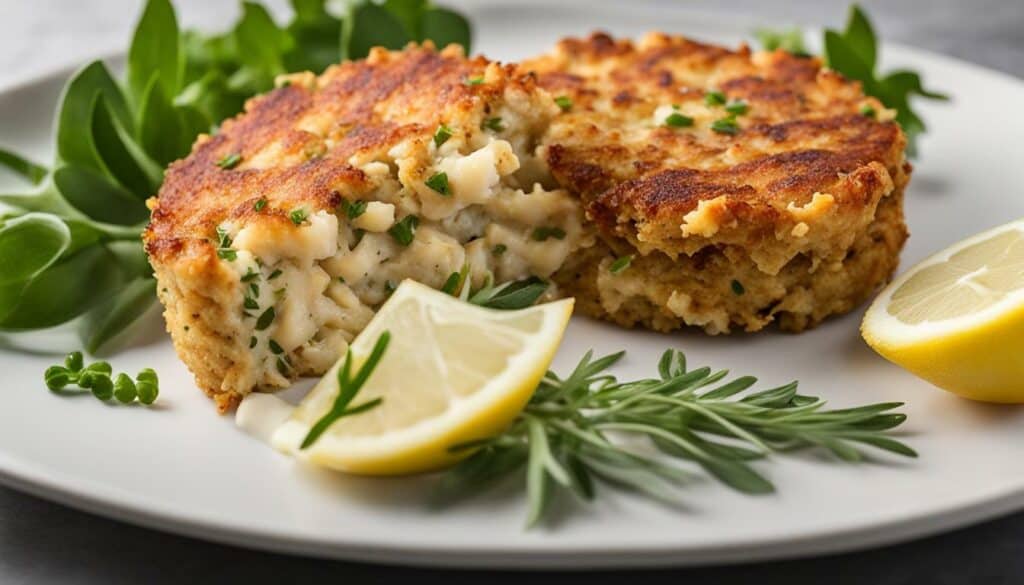
One of the impressive qualities of crab cakes is their protein content, which can support your body’s protein needs. A 3-ounce serving of crab cakes provides about 14 grams of high-quality protein. Protein is essential for muscle growth and repair, making it an important nutrient for maintaining a healthy body.
When it comes to protein sources, crab cakes offer a lean option that is low in saturated fat. This makes them an excellent choice for individuals looking to increase their protein intake without consuming excessive amounts of unhealthy fats.
Seafood, including crab, is also rich in heart-healthy omega-3 fatty acids. These essential fats have been shown to have numerous health benefits, including reducing inflammation and improving heart health. Incorporating crab cakes into your diet can help you meet your omega-3 fatty acid needs while enjoying a delicious meal.
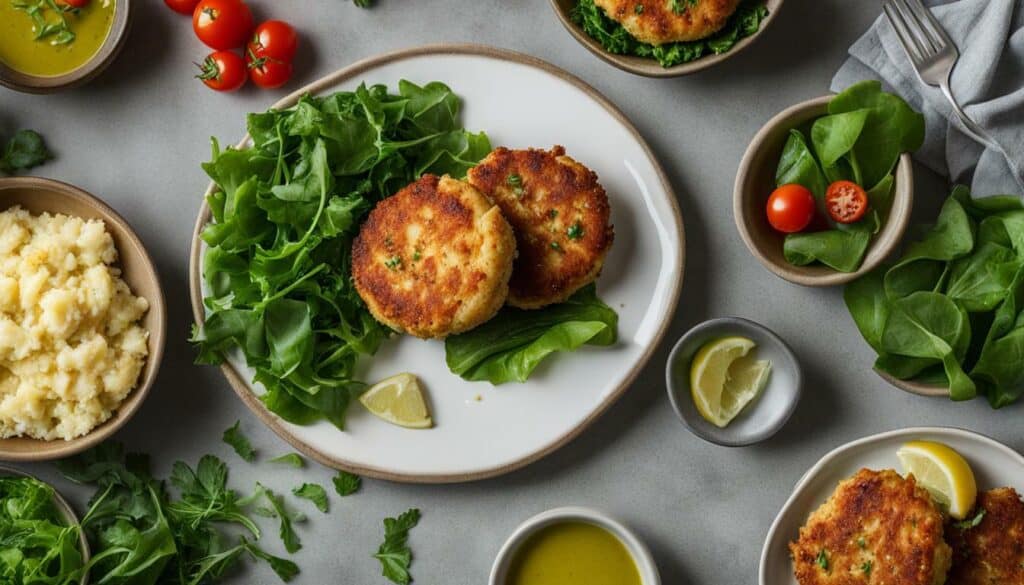
“Crab cakes are a tasty way to incorporate more protein into your diet without compromising on flavor. Their protein content can help support muscle growth and repair, making them a great choice for active individuals.”
It’s important to note that the nutritional content of crab cakes can vary depending on the recipe and cooking method. When making your own crab cakes, you have control over the ingredients used and can customize them to suit your preferences and dietary goals. Opting for baking or grilling instead of frying can reduce the fat content and make them a healthier choice.
When enjoying crab cakes, it’s also worth considering the accompaniments. Pairing them with a side salad or steamed vegetables can add fiber, vitamins, and minerals to your meal, further enhancing its overall nutritional value.
| Nutrient | Amount per 3-ounce serving |
|---|---|
| Protein | 14 grams |
| Calories | 120-160 |
| Fat | Varying amounts |
| Carbohydrates | 7-15 grams |
| Sodium | 500-800 milligrams |
Crab cakes can be a delicious and nutritious addition to your diet. They offer a good source of protein, omega-3 fatty acids, and essential vitamins and minerals. By making homemade crab cakes and choosing healthier cooking methods, you can enjoy this seafood delight while prioritizing your health and wellness.
Fat Content in Crab Cakes
While crab cakes can be a nutritious choice, it’s important to be mindful of their fat content. The amount of fat in crab cakes can vary depending on the recipe and cooking method used. Seafood itself contains heart-healthy omega-3 fatty acids, which can have numerous health benefits. However, the addition of mayonnaise or frying the cakes can significantly increase the saturated fat content.
To make healthier crab cake options, consider using lighter ingredients such as Greek yogurt or avocado instead of mayo. Baking or grilling the crab cakes instead of deep-frying can also help reduce the amount of added fat. These cooking methods still deliver a flavorful and satisfying dish while minimizing the unhealthy fats.
When enjoying crab cakes, keep in mind that moderation is key. Pay attention to portion sizes and limit the number of crab cakes you consume at one time. Opting for a side salad or steamed vegetables as a healthier accompaniment instead of french fries or creamy sauces can further enhance the nutritional value of your meal.
| Nutrient | Amount per Serving |
|---|---|
| Calories | 120-160 |
| Protein | 14g |
| Total Fat | Varies |
| Carbohydrates | 7-15g |
| Sodium | 500-800mg |
| Vitamins | Rich in B vitamins (B12, niacin, folate) |
| Minerals | Contains selenium, zinc, and copper |
| Cholesterol | Presents but can fit into a balanced diet |
By being conscious of the fat content in crab cakes and making smart choices in ingredients and cooking methods, you can enjoy this delicious dish while still maintaining a healthy diet.
Carb Considerations in Crab Cakes
If you’re watching your carb intake, it’s worth understanding the carbohydrate content in crab cakes and exploring low-calorie alternatives. While crab cakes can be a delicious seafood option, the addition of breadcrumbs or fillers can contribute to their carbohydrate content. A typical serving of crab cakes contains about 7 to 15 grams of carbohydrates, depending on the recipe.
However, if you’re looking for low-calorie options, there are ways to enjoy crab cakes with reduced carbohydrate content. One alternative is to use almond flour or crushed pork rinds instead of breadcrumbs as a binder. These substitutes can add a nutty flavor and reduce the overall carbohydrate content of the crab cakes. Additionally, opting for smaller portion sizes or mini crab cakes can help control your carbohydrate intake.
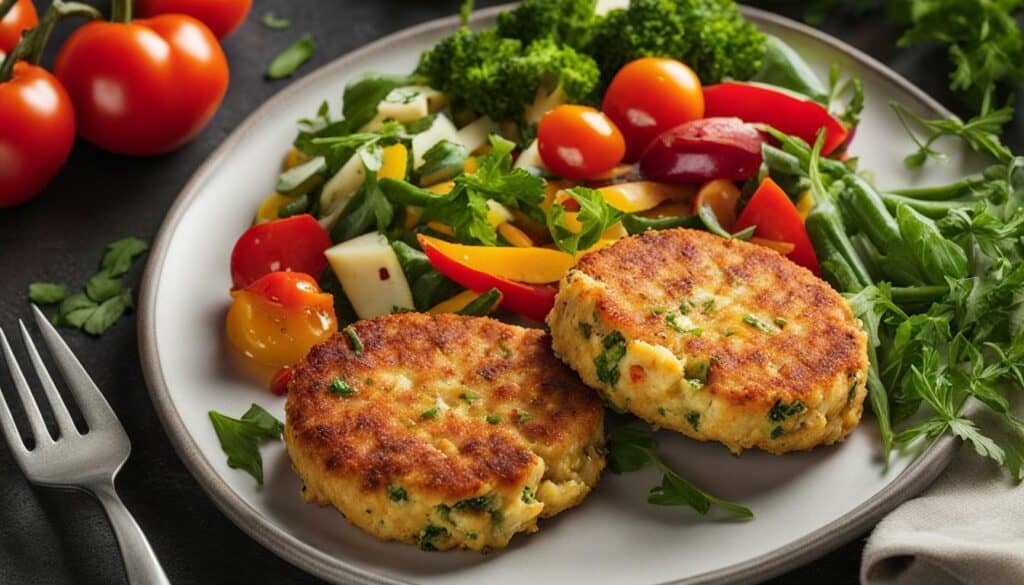
When it comes to eating crab cakes, it’s also important to consider the overall nutritional value. While carbohydrates are an essential source of energy, incorporating other macro and micronutrients into your meal is key. Crab cakes are a good source of high-quality protein, providing approximately 14 grams per 3-ounce serving. They also contain heart-healthy omega-3 fatty acids, which can help support cardiovascular health.
To enhance the nutritional value of your crab cakes, consider healthier cooking methods such as baking or grilling rather than frying. This can reduce the added saturated fats from mayo or oil, while still maintaining the flavorful taste of the dish. Pairing your crab cakes with a side salad or steamed vegetables can also add fiber, vitamins, and minerals to your meal.
Low-Calorie Crab Cake Recipe:
- Ingredients:
- 1 pound of lump crab meat
- 1/4 cup almond flour
- 1/4 cup grated Parmesan cheese
- 1/4 cup chopped parsley
- 1/4 cup diced red bell pepper
- 1/4 cup diced green onion
- 1 egg, beaten
- 1 tablespoon Dijon mustard
- 1 teaspoon Old Bay seasoning
- 1/2 teaspoon garlic powder
- 1/2 teaspoon lemon zest
- Salt and pepper to taste
- Instructions:
- In a large bowl, combine all the ingredients and mix well.
- Shape the mixture into individual crab cakes.
- Preheat the oven to 375°F (190°C) and line a baking sheet with parchment paper.
- Place the crab cakes on the prepared baking sheet and bake for 15-20 minutes, or until golden brown.
- Serve hot with your favorite low-calorie sauce or lemon wedges.
By being mindful of the carbohydrate content and choosing low-calorie alternatives, you can enjoy the taste of crab cakes while sticking to your dietary goals. Whether you’re reducing your carb intake or looking for a healthier option, these modifications ensure that crab cakes can fit into a balanced and nutritious eating plan.
The Sodium Story of Crab Cakes
Not all crab cakes are created equal when it comes to sodium content, so it’s important to be aware of how much you’re consuming. Sodium is an essential mineral that plays a critical role in maintaining fluid balance and nerve function in the body. However, excessive sodium intake can contribute to high blood pressure, heart disease, and other health issues.
When enjoying crab cakes, it’s essential to consider the overall sodium content. The sodium levels can vary depending on the recipe and seasoning used. Commercially prepared crab cakes often contain higher sodium content than homemade versions. A typical serving of crab cake can range from 500 to 800 milligrams of sodium, which is around 20-33% of the recommended daily limit.
To reduce your sodium intake while still enjoying crab cakes, you can make healthier choices. When preparing homemade crab cakes, opt for reduced-sodium ingredients and limit the use of salt or high-sodium condiments. Instead of frying the crab cakes, try baking or grilling them, which can help retain their delicious flavors while minimizing the need for extra sodium.
Pairing crab cakes with fresh, low-sodium accompaniments can also help balance your overall sodium intake. Consider serving them with a side salad or steamed vegetables, which provide additional nutrients without adding excessive sodium. By being mindful of the sodium content in your crab cakes and making smart choices, you can enjoy this delicious seafood dish while maintaining a healthy diet.
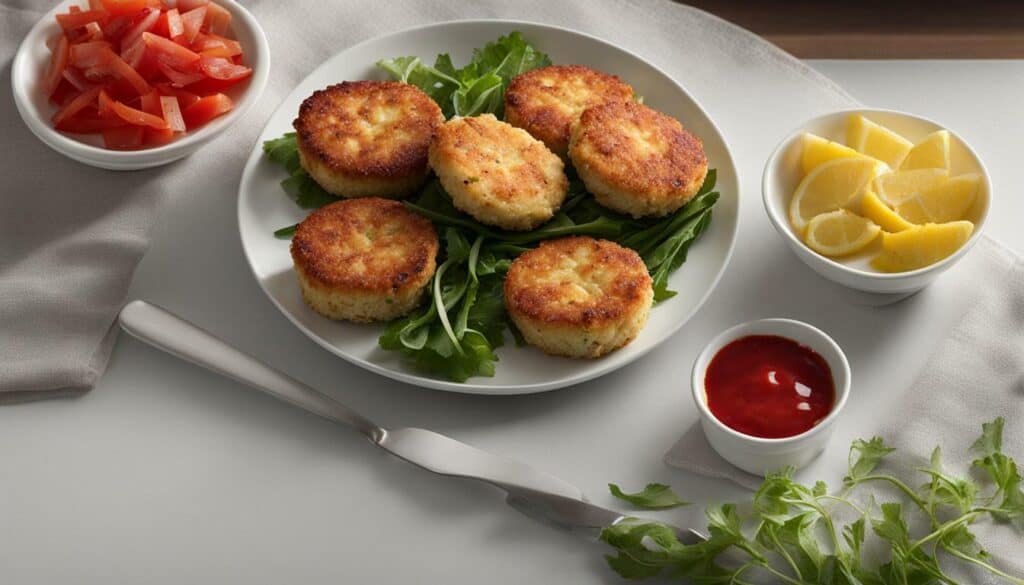
| Nutrient | Amount per 3-ounce serving |
|---|---|
| Calories | Approximately 120-160 |
| Protein | Approximately 14 grams |
| Fat | Varies depending on recipe; contains heart-healthy omega-3 fatty acids |
| Carbohydrates | Approximately 7-15 grams |
| Sodium | Approximately 500-800 milligrams |
| Vitamins and Minerals | Rich in B vitamins, selenium, zinc, and copper |
| Cholesterol | Fits into a balanced diet |
Essential Vitamins and Minerals in Crab Cakes
Crab cakes offer a range of essential vitamins and minerals that contribute to a healthy diet. These delectable seafood treats are not only a delicious choice but also a nutritious one. Let’s explore the key vitamins and minerals found in crab cakes that make them an excellent addition to your meals.
Crab meat is rich in B vitamins, particularly vitamin B12, niacin, and folate. Vitamin B12 is essential for maintaining healthy nerve cells and DNA production. Niacin plays a crucial role in converting food into energy and supporting brain function. Folate is important for cell growth and development. Including crab cakes in your diet can provide a natural boost of these beneficial B vitamins.
In addition to B vitamins, crab cakes are a great source of essential minerals. Selenium, a powerful antioxidant, helps protect cells from damage and supports a healthy immune system. Zinc plays a vital role in immune function, wound healing, and DNA synthesis. Copper is necessary for iron absorption and the production of red blood cells. Enjoying crab cakes allows you to incorporate these essential minerals into your diet.
To make the most of these nutrients, it’s important to choose fresh, high-quality crab meat and prepare the cakes using healthy cooking methods. Baking or grilling the crab cakes can help retain their nutritional value, while frying may add unnecessary saturated fats. Pair them with a side salad or steamed vegetables for a well-rounded and nutritious meal.
| Vitamin | Function | Sources |
|---|---|---|
| Vitamin B12 | Supports nerve cells and DNA production | Crab meat, fish, meat, dairy products |
| Niacin | Converts food into energy, supports brain function | Crab meat, poultry, fish, legumes, whole grains |
| Folate | Aids in cell growth and development | Crab meat, leafy greens, legumes, citrus fruits |
| Selenium | Powerful antioxidant, supports immune system | Crab meat, fish, nuts, seeds, whole grains |
| Zinc | Essential for immune function, wound healing, DNA synthesis | Crab meat, poultry, nuts, seeds, dairy products |
| Copper | Facilitates iron absorption, supports red blood cell production | Crab meat, organ meats, nuts, seeds, whole grains |
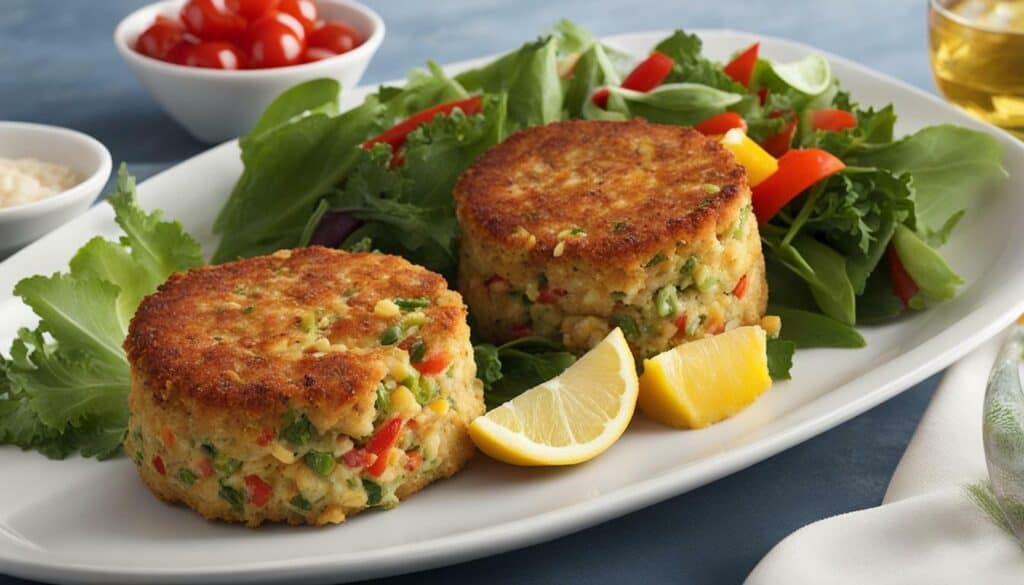
Crab cakes are not only a flavorful seafood indulgence; they also provide a wealth of beneficial vitamins and minerals. Including crab cakes in your diet can help you meet your nutritional needs while enjoying a delicious meal. Remember to choose quality ingredients, opt for healthier cooking methods, and pair your crab cakes with nutritious accompaniments for a well-rounded and satisfying dish.
Cholesterol and Crab Cakes
Despite containing cholesterol, crab cakes can still be a part of a balanced diet due to their nutrient profile. When consumed in moderation and as part of an overall healthy eating plan, the health benefits of crab cakes outweigh the potential concerns about cholesterol. Homemade crab cakes are a great source of high-quality protein, providing about 14 grams per 3-ounce serving. They are also rich in essential vitamins and minerals, such as B vitamins (like B12, niacin, and folate), selenium, zinc, and copper.
While it is true that crab meat contains some cholesterol, it is important to note that dietary cholesterol has less impact on blood cholesterol levels compared to saturated and trans fats. Moreover, the body produces its own cholesterol, so the cholesterol consumed through food has a minimal effect on overall cholesterol levels. The key is to focus on the overall nutritional value of crab cakes rather than fixating solely on the cholesterol content.
“Despite containing cholesterol, crab cakes can still be a part of a balanced diet due to their nutrient profile.”
When enjoying crab cakes, it is important to consider the cooking method and accompaniments to optimize their nutritional value. Baking or grilling crab cakes instead of frying them can reduce the overall fat content, making them a healthier option. Additionally, choosing lighter accompaniments like a side salad or steamed vegetables can further enhance the nutritional benefits of the meal.
Furthermore, if you have specific dietary preferences or restrictions, it is possible to customize crab cakes to suit your needs. Gluten-free or dairy-free versions can be made by substituting ingredients and using suitable alternatives. This flexibility allows you to enjoy the flavors and benefits of crab cakes while still adhering to your dietary goals.
To make the most of your crab cake experience, consider creating your own at home. This allows you to have complete control over the ingredients, sodium content, and cooking method. By using high-quality crab meat, opting for whole grain or gluten-free breadcrumbs, and using minimal amounts of added fats, you can create a healthier version of this beloved dish that fits into your overall dietary plan.
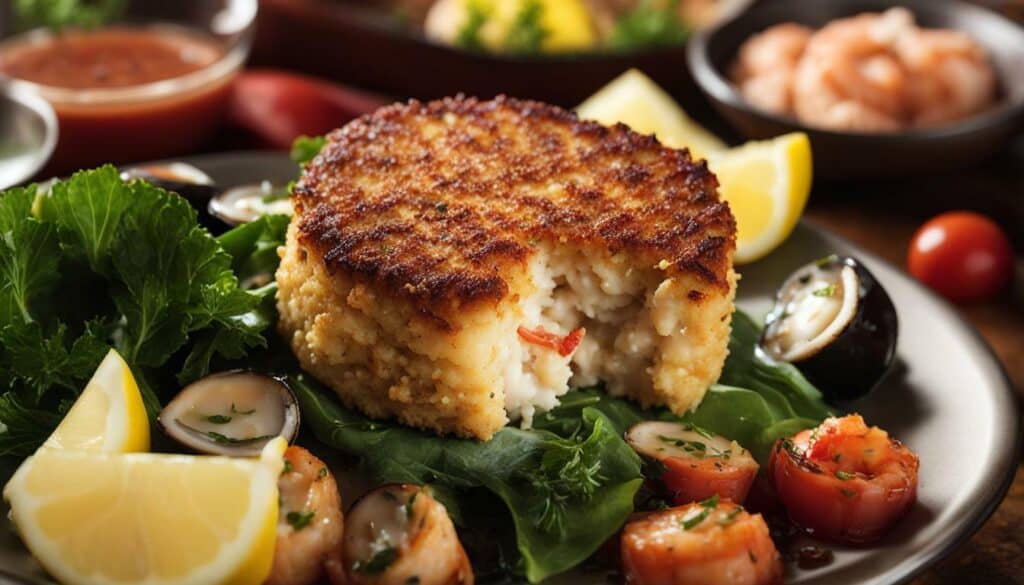
A balanced diet consists of a variety of foods, and crab cakes can certainly be included as part of a well-rounded eating plan. With their abundant protein, vitamins, and minerals, crab cakes provide numerous health benefits. Just remember to enjoy them in moderation and pair them with nutritious accompaniments for a well-rounded and satisfying meal.
Cooking Methods and Nutritional Impact
The way you cook your crab cakes can significantly impact their nutritional value, so let’s explore some healthier cooking methods. Baking or grilling crab cakes can be a great alternative to frying, as it reduces the amount of added fat and calories. These methods allow the crab cakes to retain their natural flavors and textures while minimizing the intake of unhealthy saturated fats.
When baking crab cakes, preheat your oven to 375°F (190°C) and place the cakes on a baking sheet lined with parchment paper. Bake for approximately 15-20 minutes or until they are golden brown and cooked through. This method ensures that the crab cakes are cooked evenly and are less greasy compared to frying.
Grilling is another fantastic option for imparting a smoky flavor to your crab cakes. Preheat your grill to medium-high heat, around 400°F (200°C), and lightly oil the grates to prevent sticking. Place the crab cakes directly on the grill and cook for about 4-5 minutes on each side or until they are heated through. Grilling adds a delicious charred taste to the crab cakes while reducing the need for additional fats.
By choosing these healthier cooking methods, you can enjoy the delectable flavors of crab cakes while maintaining their nutritional integrity. Remember, the choice of cooking method can make a significant difference in the overall healthiness of your meal.
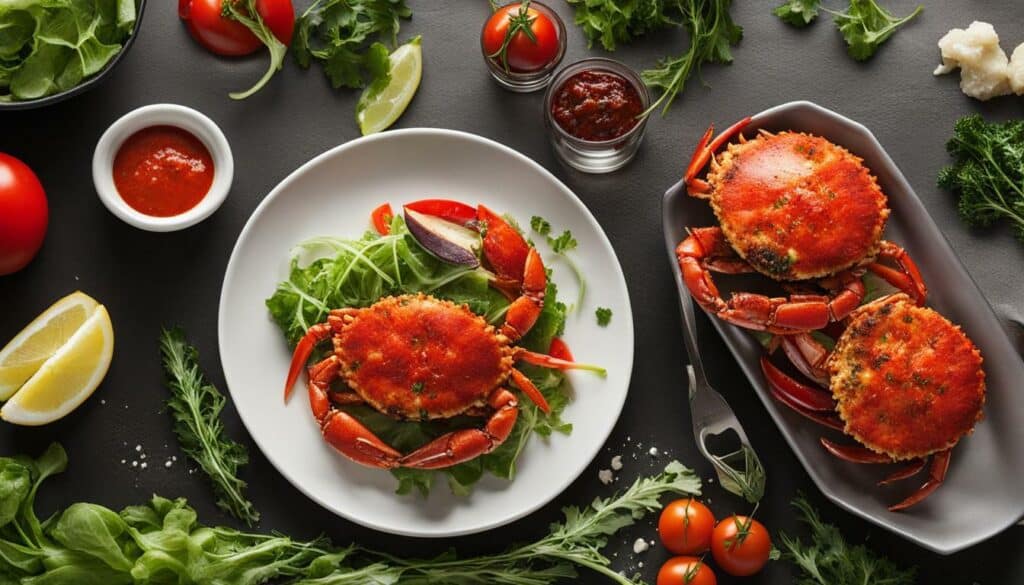
| Method | Advantages | Disadvantages |
|---|---|---|
| Baking | Retains natural flavors and textures Reduces added fat and calories Even cooking | May lack the crispy exterior of fried crab cakes |
| Grilling | Imparts a smoky flavor Reduces the need for added fats Charred exterior | Requires a grill or access to one May be less crispy than fried crab cakes |
| Frying | Provides a crispy texture | Can add significant amounts of unhealthy fats and calories May be greasier compared to other methods |
As you can see from the comparison table, baking and grilling are healthier options compared to frying when it comes to cooking your crab cakes. These methods retain the nutritional value of the crab while reducing the intake of unhealthy fats. However, if you prefer a crispy texture, frying can still be enjoyed occasionally as long as it is balanced with a nutritious overall diet.
Accompaniments and Crab Cake Nutrition
Pairing your crab cakes with the right side dishes can make a substantial difference in their overall nutritional impact. By choosing healthy options to accompany your crab cakes, you can create a well-rounded and satisfying meal that is both delicious and nourishing.
One great option is to serve your crab cakes on a bed of mixed greens or a side salad. This adds a refreshing element to your meal while providing a variety of vitamins and minerals. Leafy greens like spinach and arugula are packed with antioxidants and fiber, making them a nutritious choice.
Another option is to pair your crab cakes with roasted vegetables. This adds a burst of flavor and texture to your plate while ensuring you’re getting a good dose of vitamins and minerals. Roasting vegetables like bell peppers, zucchini, and sweet potatoes brings out their natural sweetness and enhances their nutritional value.
If you prefer a heartier side dish, consider serving your crab cakes with quinoa or brown rice. These whole grains are high in fiber and provide essential nutrients like magnesium and B vitamins. They also add a satisfying element to your meal, keeping you fuller for longer.
| Side Dish | Nutritional Benefits |
|---|---|
| Mixed Greens Salad | Antioxidants, fiber, vitamins, and minerals |
| Roasted Vegetables | Vitamins, minerals, fiber, and natural sweetness |
| Quinoa or Brown Rice | Fiber, magnesium, and B vitamins |
Remember, the key is to choose side dishes that complement the flavors of the crab cakes while also providing valuable nutrients. By making thoughtful choices and incorporating these healthy options, you can maximize the nutritional benefits of your meal without sacrificing taste or satisfaction.
Customizing Crab Cakes for Dietary Preferences
Whether you have specific dietary restrictions or preferences, there are ways to customize crab cakes to meet your needs. By making a few simple adjustments to the ingredients and cooking method, you can enjoy this delicious seafood dish while staying true to your dietary goals.
For those following a gluten-free diet, swap out regular breadcrumbs for gluten-free alternatives like almond flour or crushed gluten-free crackers. These options not only provide a similar texture but also add a nice nutty flavor to the crab cakes. Additionally, ensure that any seasonings or sauces used in the recipe are also gluten-free.
If you’re lactose-intolerant or prefer to avoid dairy, you can easily make dairy-free crab cakes by omitting ingredients like mayonnaise or sour cream. Instead, try using avocado or coconut milk-based mayonnaise as a substitute. These dairy-free alternatives still provide a creamy texture and enhance the flavor of the crab cakes.
When watching your sodium intake, be mindful of the seasonings and condiments you use in your crab cake recipe. Opt for low-sodium versions of ingredients such as Old Bay seasoning or Worcestershire sauce. Alternatively, you can reduce the salt content by using fresh herbs and spices to add flavor without adding additional sodium. Experimenting with other herbs like dill, cilantro, or basil can also bring new flavor profiles to your crab cakes.
Customizing Crab Cakes for Dairy-Free and Gluten-Free Preferences
| Preference | Ingredient Modifications |
|---|---|
| Gluten-Free | Replace regular breadcrumbs with gluten-free alternatives like almond flour or crushed gluten-free crackers. Ensure all other ingredients and seasonings are also gluten-free. |
| Dairy-Free | Omit dairy-based ingredients like mayonnaise or sour cream. Substitute with avocado or coconut milk-based mayonnaise for a creamy texture. |
| Reduced Sodium | Use low-sodium versions of seasonings and condiments. Experiment with fresh herbs and spices to add flavor without the need for extra salt. |
Customizing crab cakes to suit your dietary preferences doesn’t mean compromising on taste or quality. With a little creativity and ingredient substitutions, you can enjoy a delicious and satisfying meal that meets your unique needs. So go ahead and get creative in the kitchen, customizing your crab cakes to make them truly your own.
Conclusion on Crab Cake Nutritional Information
In conclusion, crab cakes offer a delicious and nutritious option with their moderate calorie content, high protein, and various essential vitamins and minerals. With mindful choices in ingredients, cooking methods, and accompaniments, crab cakes can be a healthier choice to savor and enjoy.
Factual data supports the notion that homemade crab cakes typically contain around 120 to 160 calories, making them a moderate-calorie option. They are also a great source of high-quality protein, with a 3-ounce serving providing about 14 grams. The fat content can vary depending on the recipe, but seafood itself contains heart-healthy omega-3 fatty acids. However, the addition of mayo or frying the cakes can add less-healthy saturated fats.
Crab cakes do contain carbohydrates due to breadcrumbs or filler, with a typical serving containing about 7 to 15 grams. One thing to be aware of is the sodium content, which can be high in crab cakes due to seasonings used and can range from 500 to 800 milligrams per serving.
Crab cakes are rich in vitamins, especially B vitamins like B12, niacin, and folate. They also provide important minerals like selenium, zinc, and copper. While crab meat does contain cholesterol, it can still fit into a balanced diet due to its rich nutrient profile.
The cooking method and accompaniments can affect the nutritional value of crab cakes, with baking or grilling being healthier choices compared to frying, and opting for healthier accompaniments like a side salad.
Crab cakes can be adapted to suit different dietary preferences, such as gluten-free or dairy-free versions. Lastly, creating your own crab cakes allows you to customize the ingredients, sodium content, and cooking method to suit your dietary goals.
FAQ on Crab Cake Nutritional Information
Q: What are the nutritional facts of crab cakes?
A: Crab cakes typically contain around 120 to 160 calories, provide about 14 grams of high-quality protein, and vary in fat content depending on the recipe. They also contain carbohydrates, with a typical serving containing about 7 to 15 grams. Crab cakes are rich in vitamins and minerals.
Q: Are crab cakes a healthy choice?
A: Crab cakes can be a healthier choice due to their moderate calorie content, high protein, heart-healthy omega-3 fatty acids, and rich nutrient profile. However, the sodium content can be high, and the cooking method and accompaniments can affect their nutritional value.
Q: Can crab cakes fit into a balanced diet?
A: Yes, crab cakes can fit into a balanced diet due to their nutrient profile. While they do contain cholesterol, the overall nutritional benefits make them a suitable choice when consumed in moderation.
Q: What cooking methods are healthier for crab cakes?
A: Baking or grilling crab cakes are healthier choices compared to frying. These methods reduce the amount of added fats and preserve the nutritional content of the crab meat.
Q: What are some healthier accompaniments for crab cakes?
A: Opting for healthier accompaniments like a side salad or steamed vegetables can enhance the nutritional value of crab cakes. Avoiding heavy sauces or creamy dressings can also reduce the overall calorie and fat intake.
Q: Can crab cakes be adapted to suit dietary preferences?
A: Yes, crab cakes can be customized to suit different dietary preferences. Gluten-free or dairy-free versions can be made by using alternative ingredients and substitutions while still enjoying the flavors and nutritional benefits of crab cakes.
Can I Make Healthier Choices at On The Border by Checking Their Nutritional Information?
At On The Border, you can make healthier choices by utilizing their comprehensive on the border nutrition information. By checking these details, you can make informed decisions about your meals, ensuring you select options that align with your health goals. Knowing the nutritional values of the dishes can guide you in making smarter choices and maintaining a balanced diet.

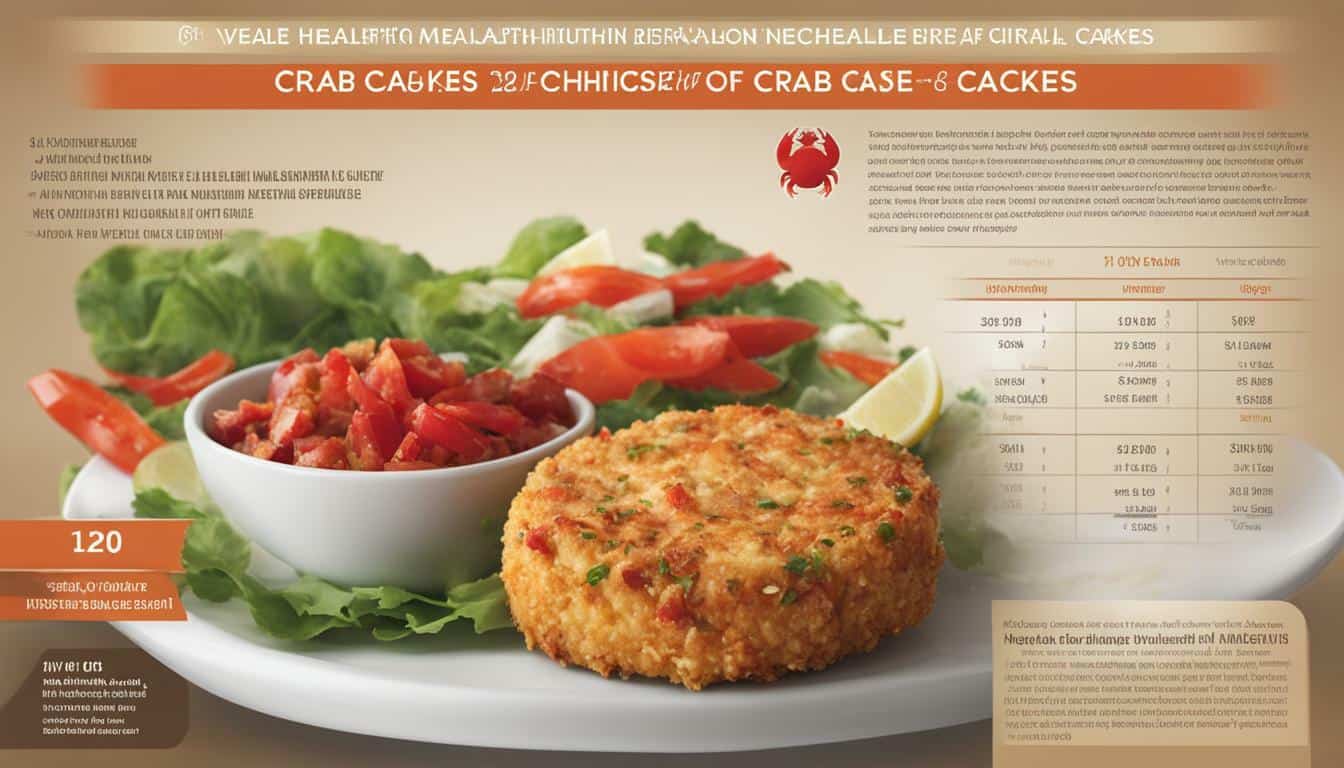



Leave a Reply